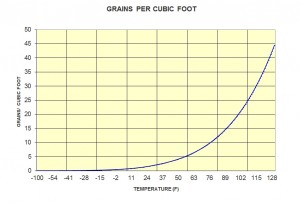High Temperatures Spell Trouble for Air Dryers
Working in the Gulf Coast region, I deal with high compressed air temperatures every day, sometimes even in the winter months. On the hottest days, the ambient temperature is often above 100°F, and compressed air temperatures can be as high as 120°F. Hot air holds more moisture. High temperatures put a heavier load on air dryers.
Unless a dryer has been designed to handle elevated temperatures, it won’t perform properly. With a regenerative dryer the excessive moisture load will exceed the capacity of the desiccant bed, resulting in higher dew points and possibly liquid downstream of the dryer.
I’ve got a customer at a petrochemical plant on the Texas Gulf Coast, operating an internally heat reactivated dryer with a design capacity of 1500 SCFM. He called not long ago to say that he was getting high dew points and liquid downstream of the dryer. He reported that the dew point was within spec most of the time, but on hot afternoons the dew point exceeded specification. I went down to the plant. First thing I did was lightly put a hand on the inlet piping to the dryer. It was almost too hot to touch.
Here’s a useful rule of thumb - if you can’t leave your hand on the inlet piping for more than a few seconds, it’s too hot. Scanning the inlet pipe with an infrared temperature gun revealed that the inlet air temperature was 118°F. Yet the dryer spec sheet showed that the unit was only designed for a maximum inlet temperature of 105°F.
As you can see from the chart below, 105°F compressed air holds 24 grains of water vapor per cubic foot or about 1.5 grams. At 118°F a cubic foot of air will holds about 35 grains. Thirteen degrees above the inlet temperature design specification might not seem like a lot. But it calculates out to moisture load almost 46% above the dryer’s design capacity! Here’s another useful rule of thumb – every 20°F of temperature increase roughly doubles the moisture load. It’s easy to see why this dryer was not making the design dew point.
|
Compressed Air Water Content |
|
|
Dew point °F |
Gr/Ft³ |
|
120 |
37 |
|
115 |
32 |
|
110 |
28 |
|
105 |
24 |
|
100 |
21 |
|
95 |
17 |
|
90 |
15 |
|
85 |
13 |
|
80 |
11 |
|
75 |
9.5 |
|
70 |
8 |
Here’s the same concept in a graph. See how moisture content climbs with temperature.
The customer and I did a careful inspection of the compressed air system. We discovered that one of two water-cooled after coolers was shut-in and not functioning. The customer performed maintenance on both coolers and brought them online. This dropped the compressed air temperature back within specification. From then on, the dryer performed fine.
A side note on after coolers. Compressor manufacturers usually build them right into the machine, often with an approach temperature of 15°F above ambient temperature. This means that on a 100°F day the air exiting the compressor will be 115°F. This might be good enough to keep the compressor running well, but it can mean havoc for the dryer. The installation of an additional after cooler or “trim” cooler upstream of the dryer will ensure the air temperature is as close as possible to the ambient temperature. Good cooling means less load on the dryer.

